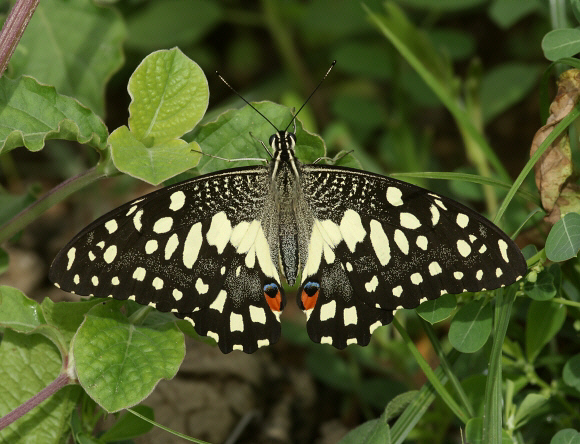
Introduction
There are about 60 species of Papilio in the Oriental region, and 210 species worldwide.
Papilio demoleus is found across most of the Oriental region from India and Sri Lanka to Vietnam and the Philippines. Its range continues south through peninsular Malaysia to Sumatra, Borneo, Sulawesi, Java, Timor, Irian Jaya, Papua New Guinea and Australia. The species has also been introduced to Central America and the Caribbean, where it is a pest of Citrus.
The butterfly bears a remarkable resemblance to the African Citrus Swallowtail P. demodocus, but the two species are not as closely related as their appearance would seem to indicate.
Habitats
This species can be found in forests but is normally associated with more open habitats ranging from semi-desert to Acacia scrub, beach hinterlands, savannah / woodland mosaics, parks and gardens. It can be found at altitudes between sea level and about 2000m.

Lifecycle
The main larval foodplant used in the Oriental region is cultivated Lime Citrus aurantifolia, on which can be a serious pest. Other Citrus species are also used, as are Atalantia, Glycosmis, Chloroxylon, Ruta, Murraya, Zizyphus, Acronichia and Microcitrus (Rutaceae). In the Australian region Psoralea and Cullen (Fabaceae) are used instead.
When young the larva is olive-brown with a suffused white saddle-mark, and strongly resembles a bird dropping. The mature caterpillar is green with a pair of narrow cream and grey mottled bands between the thoracic segments, and a pair of short knobbly tail horns.
The larvae are parasitized by Apanteles and Bracon wasps, and by Ericia Tachnid flies. The pupae are parasitized by Brachymeria and Pteromalus wasps.
Adult behaviour
In the early morning the butterflies fly low over the ground, and settle to bask for long periods on low vegetation, with their wings outspread. Later in the day as temperatures rise they become very active. Males spend their time searching for females, or mud-puddling at damp patches of ground. Females can often be seen nectaring at flowers, and research has shown that they are genetically programmed to seek blue or purple flowers in preference to other colored blooms.

